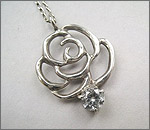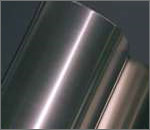Zirconium is a chemical element with the symbol Zr and atomic number 40. It is a lustrous, gray-white, strong transition metal that resembles titanium. Zirconium is used as an alloying agent due to its high resistance to corrosion. It is never found as a native metal; it is obtained mainly from the mineral zircon, which can be purified by chlorine. Zirconium was first isolated in an impure form in 1824 by Jöns Jakob Berzelius.

Zirconium has no known biological role. Zirconium forms both inorganic and organometallic compounds such as zirconium dioxide and zirconocene dichloride, respectively. There are five naturally-occurring isotopes, three of which are stable. Short-term exposure to zirconium powder causes minor irritation, and inhalation of zirconium compounds can cause skin and lung granulomas
Zirconium is a lustrous, grayish-white, soft, ductile, and malleable metal which is solid at room temperature, though it becomes hard and brittle at lower purities. In powder form, zirconium is highly flammable, but the solid form is far less prone to igniting. Zirconium is highly resistant to corrosion by alkalis, acids, salt water, and other agents. However, it will dissolve in hydrochloric and sulfuric acid, especially when fluorine is present. Alloys with zinc become magnetic below 35 K.
The melting point of zirconium is at 1855°C, and the boiling point is at 4409°C. Zirconium has an electronegativity of 1.33 on the Pauling scale. Of the elements within d-block, zirconium has the fourth lowest electronegativity after yttrium, lutetium, and hafnium.
The zirconium-containing mineral zircon, or its variations (jargoon, hyacinth, jacinth, ligure), were mentioned in biblical writings. The mineral was not known to contain a new element

until 1789, when Klaproth analyzed a jargoon from the island of Sri Lanka in the Indian Ocean. He named the new element Zirkonerde (zirconia). Humphry Davy attempted to isolate this new element in 1808 through electrolysis, but failed. Zirconium (from Syriac zargono, Arabic zarkûn from Persian zargûn meaning "gold like") was first isolated in an impure form in 1824 by Berzelius by heating a mixture of potassium and potassium-zirconium fluoride in a small decomposition process conducted in an iron tube.
The crystal bar process (or Iodide process), discovered by Anton Eduard van Arkel and Jan Hendrik de Boer in 1925, was the first industrial process for the commercial production of pure metallic zirconium. The process involved thermally decomposing zirconium tetraiodide. It was superseded in 1945 by the much cheaper Kroll process developed by William Justin Kroll, in which zirconium tetrachloride is broken down by magnesium.


